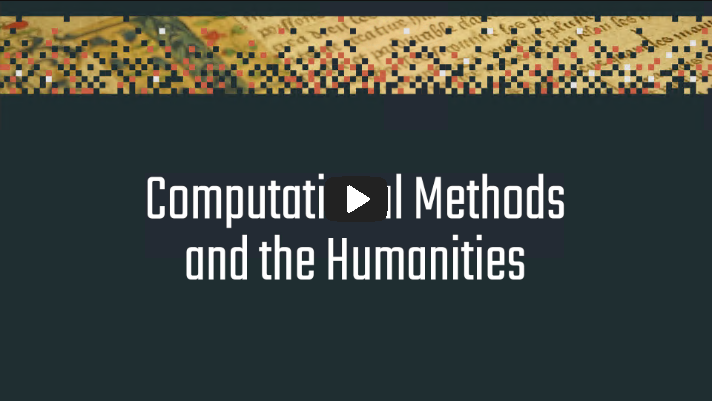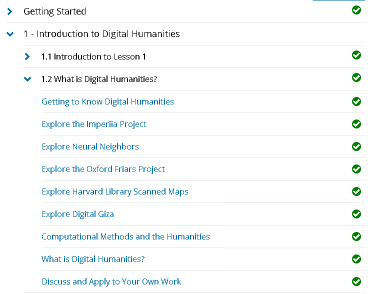In my second day studying “Digital Humanities” (DH), I watched two videos and answered two related questions.
#1 – About computational methods in DH
The student is asked to watch this:
My contribution was:
The computational methods applied to humanities research will depend not only on what the research subject is, but also on a custom research path, and other practical factors, namely resources available (including time). In this sense, the computational methods in the DH will vary as they would in other fields: they adapt or are adapted to the task, in a context that includes the researchers’ own preferences.
In the video, Jeffrey Schnapp presents one perspective, where researchers in DH tend to work either on patterns identification, or on exceptions that may break the monotony. Schnapp seemed to focus his comments on the differences, but as he spoke, he also implicitly hinted the similarities: one cannot point exceptions without a general case.
What I see as distinctive in DH research is the higher probability of the need for a multidisciplinary approach to problems.
Human behavior and human expression, in any form, can eventually be modelled as computational data and logic, and even one day be automatically researched (!) with Artificial Intelligence (A.I.). If that day is to arrive, the A.I. must learn from what I perceive as an infinite pool of different possible questions, different desired visualizations, different sensibilities, different audiences in need of answers, etc. Handling this beautiful diversity may be a strong and appealing characteristic of DH research.
#2 – About what is DH?
The student is asked to watch this:
My contribution was:
I enjoy writing, including writing computer software. For years, I felt computers demanded more than what they gave me back; hence, I gained an interested in task automation, including automatic file organization, and several forms of automatic Internet activities. I think that part of my software developer experience can be helpful in DH research; for example in ingesting and processing data from different sources.
But there is a very significant shift going on, towards the use of certain Artificial Intelligence (A.I.) and Machine Learning (M.L.) frameworks, for many potentially DH related tasks.
The effectiveness of that AI/ML approach can be stellar; yet it may come with a “freedom” and “pleasure” cost. Researchers have to abstract ever-greater layers of logic: at this stage, many researchers become mere users of processes that they do not understand, and do not have to, since their focus is the “results”.
In my view, there is this “abstraction frontier” that can be set to a critical level; once the line is crossed, one risks paying a “motivational” and “pleasure” price, factors once too many times not acknowledged as important to do sustainable research.
Suzanne Blier mentions “fun” in the video. Racha Kirakosian mentions “you don’t have to be an expert in everything”, hinting this abstraction now required to handle different and complex computational tools.
Long story short: I would probably have more fun in using digital tools totally developed by myself, but that has become impossible. I should be grateful if I can understand a required minimum to make effective use of what tools are available.
#3 – I also commented on colleague’s (Alex Kashkine) post:
Yes, to me, that also seems significant in DH. Yet, I think DH goes beyond digitalization, statistics, and open access for collaborative work. Tools can produce new data, not directly available in the input documents. For example, one day I watched a NHK Japan documentary about how researchers, after having trained software to reckon ancient calligraphy, were able to “complete” poorly preserved scripts and extract full text from originals with many missing bits. This would be an example based on tangible historical evidence, made “intangible” and subject to a digital interpretation process.
In other applications, totally new data can be created.


Technical Details
- ./ups/edx_idh_computational_methods_and_the_humanities_poster.png
- attachment_id : 464
- date_created_gmt : 2019-07-20 20:03:16
- parent : 0
- link : https://arturmarques.com/wp/wp-content/uploads/2019/07/edx_idh_computational_methods_and_the_humanities_poster.png
- title : edx_idh_computational_methods_and_the_humanities_poster.png
- caption :
- description :
- metadata :
- width : 712
- height : 401
- file : 2019/07/edx_idh_computational_methods_and_the_humanities_poster.png
- sizes :
- thumbnail :
- file : edx_idh_computational_methods_and_the_humanities_poster-150×150.png
- width : 150
- height : 150
- mime-type : image/png
- medium :
- file : edx_idh_computational_methods_and_the_humanities_poster-300×169.png
- width : 300
- height : 169
- mime-type : image/png
- post-thumbnail :
- file : edx_idh_computational_methods_and_the_humanities_poster-672×372.png
- width : 672
- height : 372
- mime-type : image/png
- thumbnail :
- image_meta :
- aperture : 0
- credit :
- camera :
- caption :
- created_timestamp : 0
- copyright :
- focal_length : 0
- iso : 0
- shutter_speed : 0
- title :
- orientation : 0
- keywords :
- type : image/png
- thumbnail : https://arturmarques.com/wp/wp-content/uploads/2019/07/edx_idh_computational_methods_and_the_humanities_poster-150×150.png
- id : 464
- file : edx_idh_computational_methods_and_the_humanities_poster.png
- url : https://arturmarques.com/wp/wp-content/uploads/2019/07/edx_idh_computational_methods_and_the_humanities_poster.png
- ./ups/edx_idh_what_is_dh_poster.png
- attachment_id : 465
- date_created_gmt : 2019-07-20 20:03:19
- parent : 0
- link : https://arturmarques.com/wp/wp-content/uploads/2019/07/edx_idh_what_is_dh_poster.png
- title : edx_idh_what_is_dh_poster.png
- caption :
- description :
- metadata :
- width : 712
- height : 400
- file : 2019/07/edx_idh_what_is_dh_poster.png
- sizes :
- thumbnail :
- file : edx_idh_what_is_dh_poster-150×150.png
- width : 150
- height : 150
- mime-type : image/png
- medium :
- file : edx_idh_what_is_dh_poster-300×169.png
- width : 300
- height : 169
- mime-type : image/png
- post-thumbnail :
- file : edx_idh_what_is_dh_poster-672×372.png
- width : 672
- height : 372
- mime-type : image/png
- thumbnail :
- image_meta :
- aperture : 0
- credit :
- camera :
- caption :
- created_timestamp : 0
- copyright :
- focal_length : 0
- iso : 0
- shutter_speed : 0
- title :
- orientation : 0
- keywords :
- type : image/png
- thumbnail : https://arturmarques.com/wp/wp-content/uploads/2019/07/edx_idh_what_is_dh_poster-150×150.png
- id : 465
- file : edx_idh_what_is_dh_poster.png
- url : https://arturmarques.com/wp/wp-content/uploads/2019/07/edx_idh_what_is_dh_poster.png
